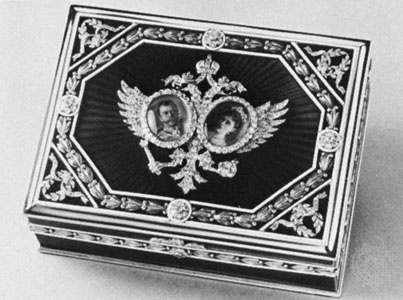Fabergé, Peter Carl
Russian jeweler
original name Karl Gustavovich Fabergé
born May 18, 1846, St. Petersburg, Russia
died Sept. 24, 1920, Lausanne, Switz.
 one of the greatest goldsmiths, jewelers, and designers in Western decorative arts.
one of the greatest goldsmiths, jewelers, and designers in Western decorative arts.Of Huguenot descent, Fabergé was educated in Germany, Italy, France, and England. His father had by 1842 established himself in St. Petersburg as a jeweler, dealing also in fine decorative objects, a tradition Peter Carl continued after inheriting the family business in 1870. He began to manufacture decorative objects, later showing his works in Moscow's Pan-Russian Exhibition (1882). His reputation was swiftly established, and European royalty, particularly Russian, patronized him.
Assisted by his sons and by associates headed by the Swiss artisan François Berbaum, Fabergé gained recognition as a brilliant designer, specializing in such precious and semiprecious materials as gold, silver, malachite, jade, lapis lazuli, and gems. He made a bold change from the exclusive design and manufacture of conventional jewelry to the creation of objects of fantasy. Much of his work was inspired by the decorative arts executed under King Louis XVI of France. Soon other independent workshops opened under his supervision at Moscow, Kiev, and London; outstanding among the artisans he hired was the master craftsman Michael Perchin.
Fabergé's workshop soon became famous for exquisite and ingenious masterpieces: flowers, figure groups, bibelots, animals, and, above all, the celebrated imperial Easter eggs, which became the delight of Russian and other royalty throughout Europe and Asia. Emperor Alexander III commissioned the first of the eggs for his tsaritsa in 1884, and Alexander's successor, Nicholas II, continued the tradition. Fabergé's studios created outstanding works of imaginative delicacy until the Russian Revolution of 1917; then his world ended, for the new government would not tolerate any object of luxury, and he died in exile.
- Marguerite Clark
- Marguerite Duras
- Marguerite Gardiner Blessington, Countess of
- Marguerite Gardiner, Countess of Blessington
- Marguerite Taos Amrouche
- Marguerite Young
- Marguerite Yourcenar
- Marguerite-Élie Guadet
- Margulis, Gregori Aleksandrovich
- Margunios, Maximus
- Mari
- Maria Agustina Bessa Luís
- Maria Aurora, Countess von Königsmark
- Maria Aurora Königsmark, Countess von
- Maria Callas
- Maria Carolina
- mariachi
- Maria Dermoût
- Maria Dąbrowska
- Maria Edgeworth
- Maria Elena Vieira da Silva
- Maria Ester Audion Bueno
- Maria Fitzherbert
- Maria Gaetana Agnesi
- Maria Goeppert Mayer